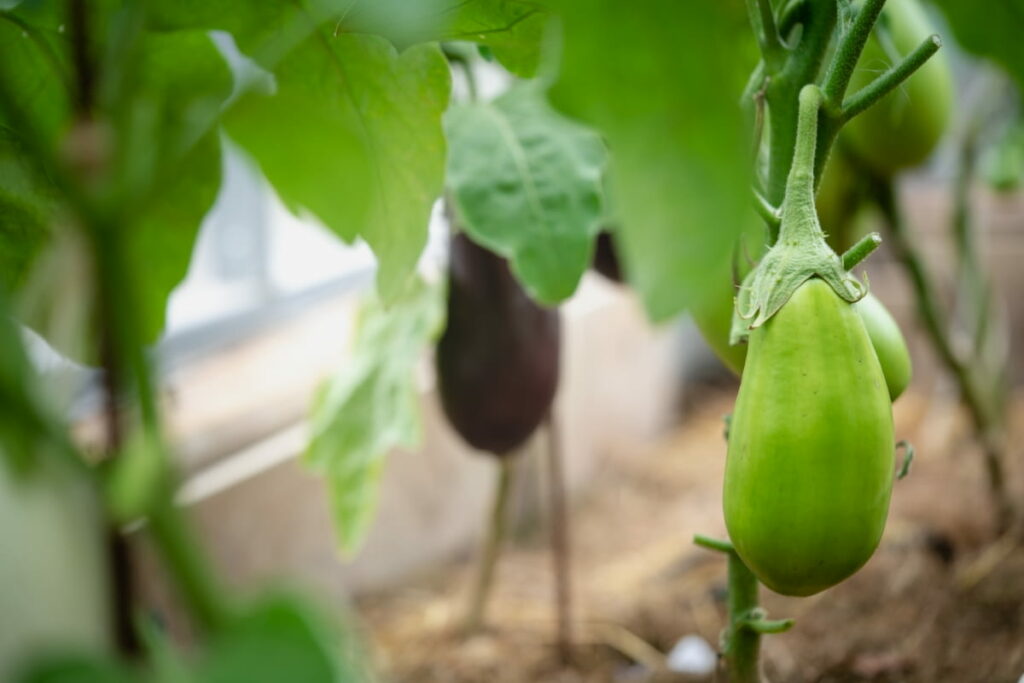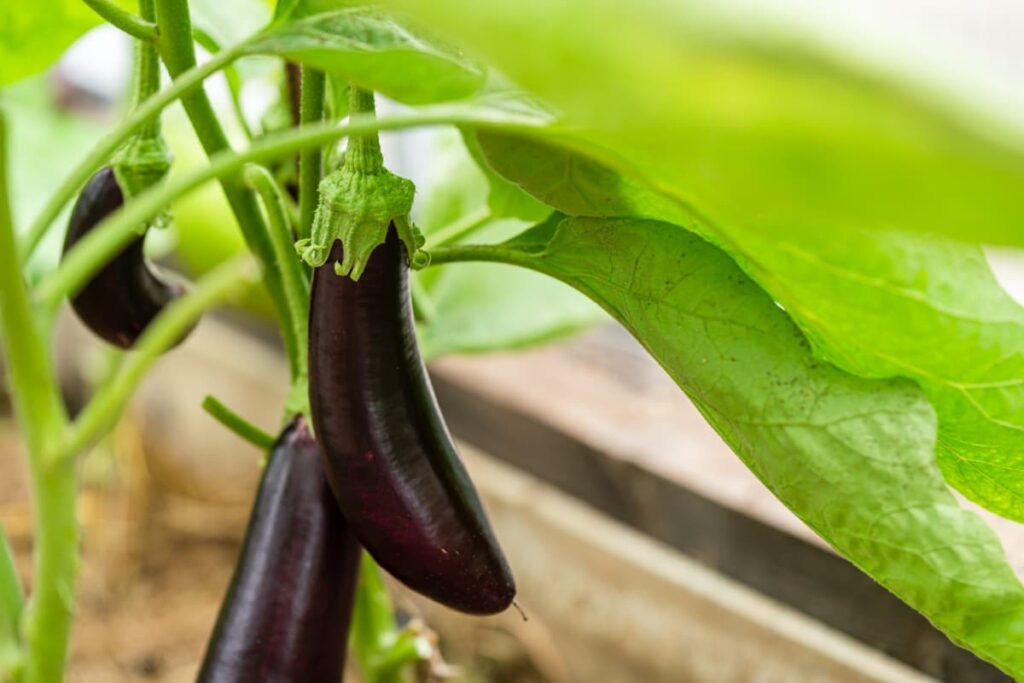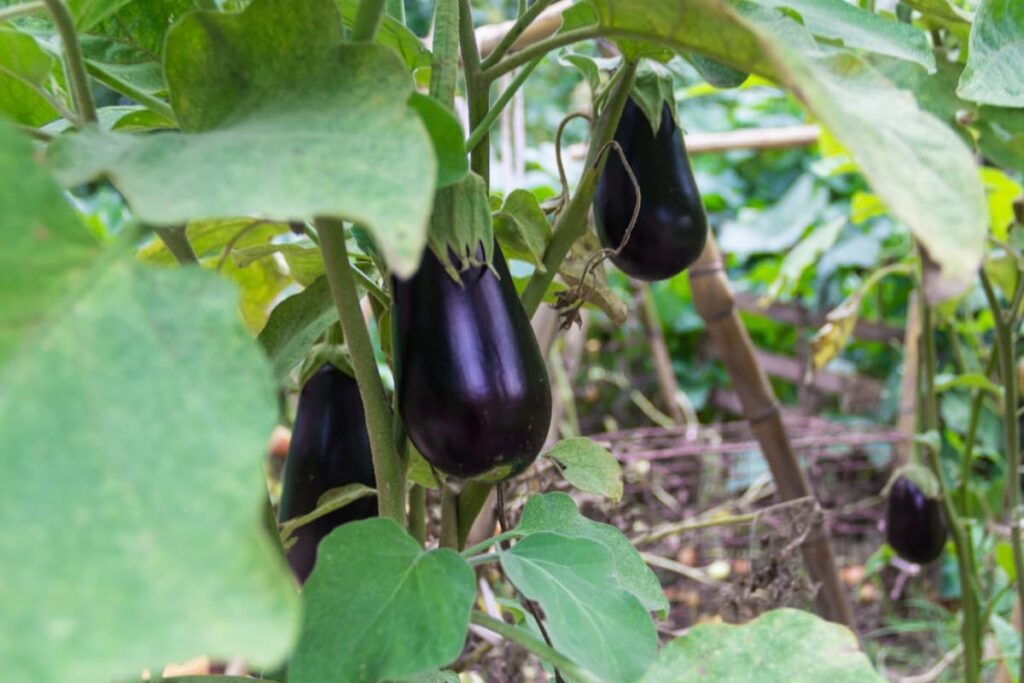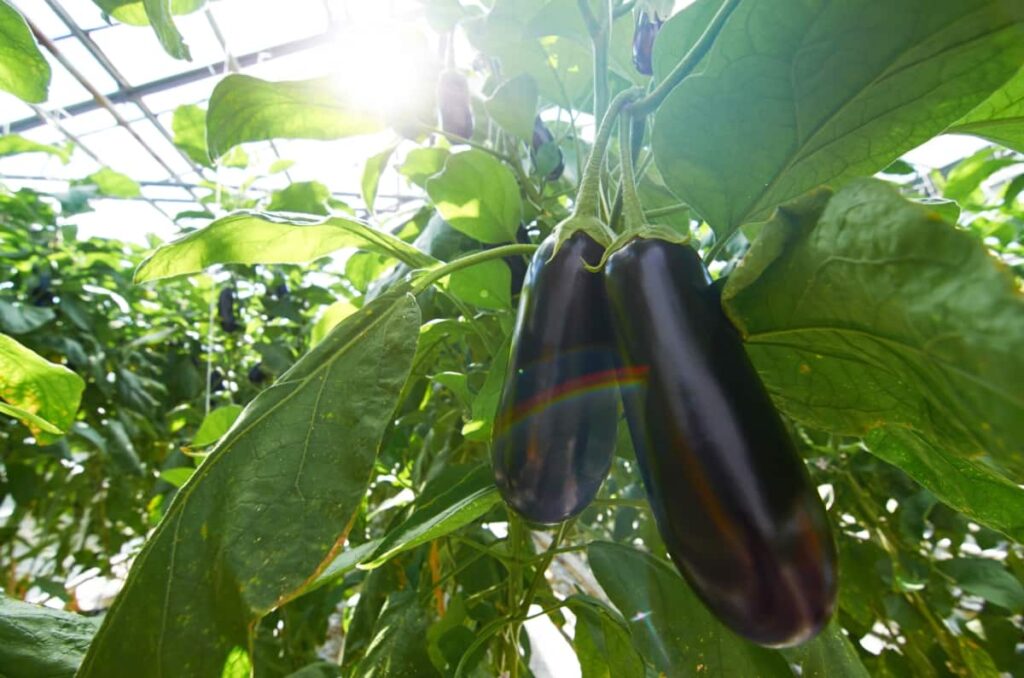Polyhouse Brinjal Cultivation offers a controlled environment for Growing Brinjal in Polyhouse, ensuring optimal conditions for Hydroponic Brinjal Growth. Learn essential Polyhouse Eggplant Growing Techniques and Organic Brinjal Cultivation practices to maximize yield.

How to Grow Brinjal in Polyhouse
Introduction to Brinjal Cultivation in Polyhouses
Eggplant, alternatively referred to as aubergine, is a commonly grown vegetable belonging to the Solanaceae family. It prefers tropical and subtropical climates and is prized for its versatile culinary applications. Renowned for its nutritional value, eggplant boasts abundant antioxidants, dietary fiber, vitamins, and minerals, offering numerous health advantages.
Overview of Brinjal and Its Varieties
The brinjal, also known as eggplant, is typically grown as an annual crop despite being a perennial plant. It displays a bushy growth pattern characterized by stems that are woody towards the bottom and herbaceous towards the apex. Its leaves are typically ovate to lanceolate in shape, featuring serrated edges and hairy surfaces. The fruit, resembling berries, showcases a diverse range of shapes, sizes, colors, and textures, which vary based on the specific variety being cultivated.
Advantages of Polyhouse Farming for Brinjal
- Protection from adverse weather: Shields crops from frost, hail, wind, and rain.
- Extended growing season: Allows for more crop cycles.
- Improved growth and development: Optimizes temperature, humidity, light, and air circulation.
- Reduced resource usage: Efficient irrigation and fertigation lower water and fertilizer needs.
- Decreased pest and disease impact: Limits vectors and pathogens.
- Enhanced yield and quality: Improves pollination and fruit setting for brinjal.
- Lowered costs: Automation and mechanization reduce labor and operational expenses.
Setting Up the Polyhouse
To establish a brinjal polyhouse, consider site location, orientation, size, materials, budget, and purpose. These factors shape design and construction decisions for efficient growth and resource optimization.
Design and Construction of a Suitable Polyhouse
- Foundation: Supports and anchors a playhouse made of concrete, bricks, stones, or metal pipes.
- Frame: Provides shape and support, made of wood, bamboo, metal, or plastic.
- Covering: Transparent, UV-stable material like polyethylene or polycarbonate.
- Door: Lockable entrance made of wood, metal, or plastic.
- Ventilation: Natural or artificial air circulation.
- Cooling: Passive (shading, evaporative cooling) or active (refrigeration, misting).
- Heating: Direct (heaters, burners) or indirect (heat exchangers, solar collectors).
Essential Equipment for Polyhouse Environment Control
- Sensors: Measure environmental parameters like temperature, humidity, and CO2 levels; analog/digital, wired/wireless, fixed/portable; accuracy, sensitivity, and calibration crucial.
- Controllers: Regulate systems like ventilation and irrigation; manual/automatic, programmable/non-programmable, centralized/decentralized; user-friendly, responsive, and compatible for optimal plant growth control.
- Recorders: Store/display sensor data; paper/electronic-based, online/offline, graphical/numerical; secure, accessible, and comprehensive for historical analysis/evaluation.
Soil Preparation and Bed Formation
Preparing the soil and creating a bed are the first steps in growing brinjal in a polyhouse. It’s important to guarantee that the soil has a loamy texture, is well drained, is fertile, and preferably has a pH of 6.5 to 7.5. In addition, there should be no diseases, stones, weeds, or residue in the soil.
Soil Composition and Nutrient Requirements
Polyhouse brinjal cultivation demands higher nutrient levels due to intensive cropping. Key nutrients include N, P, and K as major ones, followed by secondary (Ca, Mg, S) and micronutrients (Fe, Mn, Zn, Cu, B, Mo). Recommended application ranges from 120-150 kg N, 60-80 kg P, and 80-100 kg K per hectare, adjusted based on soil test results.
Techniques for Bed Preparation and Layout
- Prepare beds 15-20 days pre-transplanting for soil settling and organic matter decomposition.
- Thoroughly water beds before transplanting to moisten the soil.
- Mark beds with rope/stick for rows/columns according to plant spacing.
- Cover beds with plastic mulch, securing them with pegs and holes for seedling insertion.
- Arrange beds for sunlight, air circulation, and easy management in the polyhouse.
In case you missed it: Best Practices to Grow Brinjal/Eggplant at Home: Check How this Guide Helps Beginners

Seed Selection and Germination
The next step in polyhouse brinjal cultivation is to select and germinate the seeds. The seeds should be of high quality, certified, disease-free, and suitable for polyhouse cultivation. The seeds should also be of the desired variety, color, shape, size, and flavor of brinjal.
Choosing the Right Brinjal Varieties for Polyhouse Cultivation
- Arka Kusumakar: Oval purple fruits with white stripes, yields 60-70 tonnes/ha, developed by ICAR-IIHR, Bangalore.
- Arka Anand: Round purple fruits with green calyx, yields 50-60 tonnes/ha, developed by ICAR-IIHR, Bangalore.
- Arka Shirish: Long purple fruits, yields 40-50 tonnes/ha, developed by ICAR-IIHR, Bangalore.
- Pusa Purple Long: Long purple fruits with green calyx, yields 30-40 tonnes/ha, developed by IARI, New Delhi.
Seed Germination Techniques and Seedling Care
- Create sterile potting mix: blend equal parts cocopeat, vermicompost, and perlite, or use a pre-made mix.
- Fill trays/pots and lightly moisten the mix.
- Sow seeds 0.5 cm deep and cover with a thin mix layer.
- Place in a shaded, ventilated area (25-30°C, 70-80% humidity).
- Water daily with mist or drip irrigation.
- Apply diluted seaweed extract/humic acid weekly.
- Monitor for pests/diseases.
- Germination: 5-7 days; transplant in 25-30 days.
Transplanting and Plant Management
Once you have selected the seeds, you need to germinate them in a nursery before transplanting them into the polyhouse. The seed germination process involves the following steps.
Transplanting Seedlings into the Polyhouse
- Level the polyhouse site and clear debris.
- Install drip irrigation and fertigation systems.
- Set up climate control with sensors, fans, and shade nets.
- Prepare raised planting beds and add organic matter.
- Apply basal fertilizers and make planting holes.
- Transplant seedlings, water, foliar spray micronutrients.
Spacing and Training of Brinjal Plants
- Maintain 25,000-30,000 plants per hectare in polyhouse brinjal cultivation for optimal space, light, and nutrient use.
- Regularly prune brinjal plants to remove diseased, damaged, or unwanted branches, improving air circulation and reducing pests.
- Train plants to grow on a single stem, enhancing light penetration and facilitating harvesting.
- Support plants with stakes or trellises to prevent lodging and fruit damage.
Climate Control and Environmental Management
Climate control and environmental management are crucial factors that determine the success of playhouse brinjal cultivation. The climate control and environmental management involve the following steps.
Maintaining Optimal Temperature and Humidity
- Polyhouse temperature: Daytime 25-30°C, nighttime 18-22°C.
- Hot weather: Use fans and pads to cool.
- Cold weather: Employ heaters and and and thermal screens.
- Relative humidity: 60-70%.
- Dry weather: Use foggers and misters.
- Wet weather: Employ ventilators and dehumidifiers.
Light and Air Circulation Requirements
- Polyhouse requires 5000-7000 lux light intensity; adjust with shade nets or artificial lights.
- Maintain CO2 levels at 800-1000 ppm; use generators or exhaust fans accordingly.
Irrigation and Fertilization
Irrigation and fertilization are essential practices that influence the growth, yield, and quality of brinjal in polyhouse cultivation.
Efficient Watering Systems for Polyhouses
Drip irrigation and sprinkler irrigation are recommended for polyhouse brinjal cultivation due to tailored water needs. Drip systems conserve water, enhance nutrient uptake, and curb weed growth. Sprinklers provide even water distribution, cool the environment, and aid photosynthesis. However, they may waste water and promote fungal diseases. The choice between them hinges on various factors, including soil, climate, and water availability.
Fertilizer Types and Application Schedules
For polyhouse brinjal cultivation, a balanced combination of organic and chemical fertilizers is recommended. Organic fertilizers improve soil health but have limitations, while chemical fertilizers provide precise nutrients but may harm the environment. Common chemical fertilizers include N, P, K, and micronutrients. Application varies based on growth stages. Micronutrients like Ca, Mg, and Fe are crucial and applied via foliar sprays or soil drenches.
Pest and Disease Management
Pest and disease management is crucial in brinjal cultivation. It involves Identifying common pests and diseases in Brinjal and implementing organic and chemical control strategies.
Identifying Common Pests and Diseases in Brinjal
Brinjal faces vulnerability to a range of pests and diseases, posing threats to both yield and crop quality. Some of the common pests and diseases that affect brinjal in polyhouse are.
- Pests: Aphids, thrips, whiteflies, leafminers, spider mites, mealybugs, fruit borers, shoot borers, root-knot nematodes, etc.
- Diseases: Damping-off, wilt, blight, leaf spot, mosaic virus, bacterial wilt, anthracnose, etc.
Organic and Chemical Control Strategies
To ensure successful polyhouse cultivation of brinjal, start with healthy seeds, choose resistant varieties, and maintain hygiene by removing weeds and infected plants. Monitor pests regularly, employing physical barriers and biological agents. Reserve chemical pesticides as a last resort, adhering strictly to recommended usage for safety.
Pollination and Yield Enhancement
Pollination plays a crucial role in terms of yield enhancement, so several techniques are available to promote pollination.
Techniques to Promote Effective Pollination
- Provide adequate ventilation in the polyhouse by opening the side curtains or using fans.
- Maintain optimal temperature (25-30°C) and relative humidity (60-70%) in the polyhouse
- Introduce pollinator insects such as honey bees or bumble bees in the polyhouse
- Use artificial pollination methods such as hand pollination or electric pollination.
Practices to Maximize Yield and Fruit Quality
For high-yield brinjal cultivation in polyhouses, opt for high-yielding varieties and employ hydroponic systems for optimal nutrient and water supply. Regular pruning and pinching off terminal buds promote lateral growth and fruiting. Support plants with stakes to prevent damage, thin fruits for uniformity, and harvest when dark purple and firm.
In case you missed it: Brinjal Pest and Disease Management: Control with Chemical, Biological, and Organic Methods

Harvesting and Post-Harvest Handling
Once your brinjal plants have reached the desired maturity and the fruits have developed to the appropriate size, it’s time to initiate the harvesting process. Proper harvesting techniques, followed by effective post-harvest handling, are crucial steps to preserve the quality and freshness of the produce.
Identifying Harvesting Maturity and Methods
- Color: The fruits change from green to dark purple or black when mature
- Gloss: The fruits have a shiny surface when mature
- Firmness: The fruits are firm but not hard when mature
- Size: The fruits reach their optimum size when mature
Storage and Marketing of Brinjal
- Sort and grade the fruits according to size, shape, color, and quality
- Pack the fruits in perforated plastic crates or baskets lined with newspaper or straw.
- Avoid stacking the crates or baskets too high to prevent bruising and damage.
- Transport the fruits to the market as soon as possible or within 24 hours of harvest.
- Sell the fruits at a fair price and in attractive displays.
In case you missed it: Eggplant Farming (Brinjal) Information Guide

Conclusion
Polyhouse Brinjal Cultivation presents a promising avenue for High Yield Brinjal Varieties in Polyhouse settings. With careful Polyhouse Brinjal Fertilization and effective Brinjal Pest Control measures, growers can achieve success in Brinjal Polyhouse Farming, ensuring sustainable production and premium-quality eggplants.
- Crops Grown in Summer Season: Best Choices for Summer Gardening
- Organic Pest Control for Tomato Farming
- How to Maximize Sheep Farming Profit
- Broccoli Varieties: Choosing the Right Cultivars for Your Farm
- How to Raise Pigs in Your Own Backyard: A Comprehensive Guide
- Budget Friendly Sheep Shed Ideas: Cheap and Low-Cost Tips
- How Much Do Cattle Farmers Make: Revenue Streams in Cattle Farming
- Management Pests and Diseases in Your Cotton Field
- Sheep Farming Business Plan for Beginners
